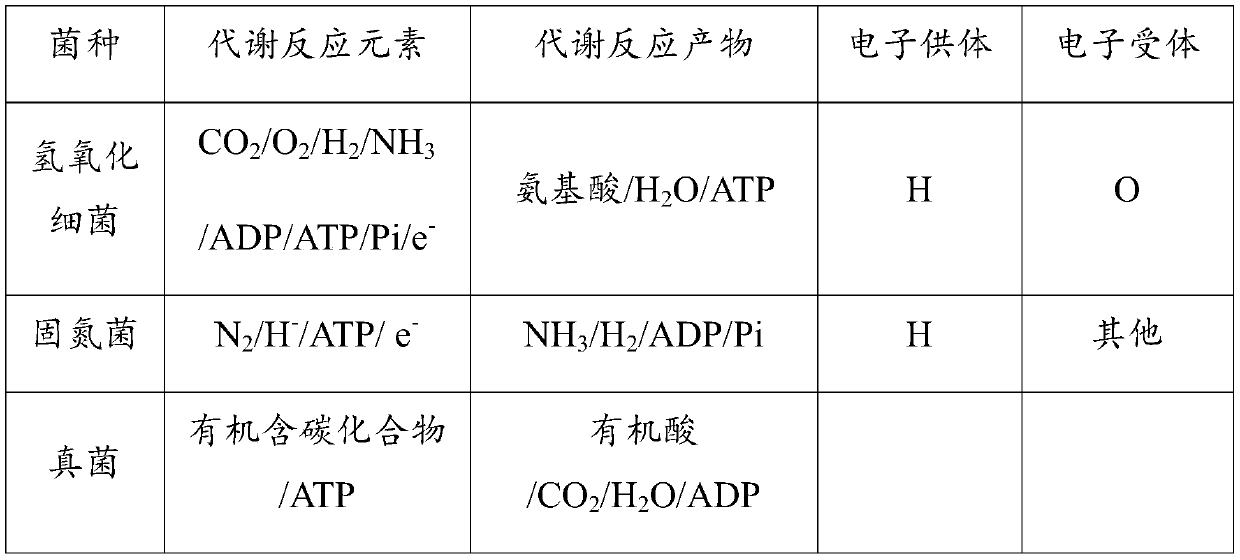Compound strain based on hydrogen hydroxide bacteria and culture method thereof
A technology of compound strains and culture methods, applied in the field of microorganisms, can solve the problems of low abundance ratio of strains and unfavorable industrial application
- Summary
- Abstract
- Description
- Claims
- Application Information
AI Technical Summary
Problems solved by technology
Method used
Image
Examples
Embodiment 5
[0064] This embodiment provides a method for preparing the synthetic medium of the present invention, and the specific steps are as follows:
[0065] (1) The organic compound is prepared according to the ratio of Example 1 and the mixed solution is stirred and dispersed evenly.
[0066] (2) The minerals are configured according to the ratio of Example 1, added to the mixed liquid of organic compounds, stirred and dispersed uniformly, and the minerals form a suspended dispersion state in the mixed liquid of organic compounds, with high visual turbidity and no light transmission.
[0067] (3) Add pure water to dilute to make the total weight 100kg, continue to stir and disperse, and obtain a liquid synthetic medium after dilution.
[0068] (4) The liquid synthetic medium is sterilized in cycles through an ultraviolet light device, and the sterilization time is> 30 min. Put the sterilized medium into the culture container.
[0069] The culture medium prepared in Examples 1 to 4 was tested...
Embodiment 6
[0073] Example 6 Cultivation method of composite strain
[0074] Step 1: From under the vegetation of the original ecological environment in Dinghushan National Nature Reserve, Guangdong, China, take the high humidity turf soil with a humidity of 16%, stir and dilute with water to precipitate, and take 1L of the supernatant as the primary strain;
[0075] Step 2: Inoculate the primary strains into the liquid medium of Example 1 for cultivation, and pass in compressed air. The volume ratio of liquid to air flow is 1m 3 :5-15m 3 / h, preferably, the air flow is 0.8-1m 3 / h, the temperature is controlled to 28-32°C, preferably 30-32°C. After 7 days of enrichment culture, the gas supply is stopped, and the precipitation is allowed to stand for 24 hours. After the minerals settle to the bottom of the container, the supernatant is separated to obtain the secondary strain.
[0076] Step 3: Take the secondary strains and put them into the same reaction vessel; pass in compressed air with an a...
Embodiment 7
[0087] This example uses the method for culturing the composite strain of Example 6. This example uses the culture medium prepared in Example 2. The only difference between this example and Example 6 is that the first step of this example is from the national level of Mangshan, Hunan, China. Under the vegetation of the original ecological environment of the nature reserve, take 30% high-humidity turf soil, dissolve the water, stir and dilute it to precipitate, and take 1L of supernatant as the primary strain.
[0088] In this example, samples were taken at the culture time points 0h, 24h, 36h, 72h, 96h, 7 days, 14 days, and 21 days for testing. The test results are shown in Table 6.
[0089] Table 6: Test results at different time points in the cultivation process of Example 7
[0090]
[0091] Remarks: ①Represents Hydrogenophaga laconesensis HWB-10 T ②Represents Pseudomonas wadenswilerensis CCOS 864T ③Represents Azospirillum rugosumIMMIB AFH-6T ④Represents Varicosporellopsis aquatil...
PUM
 Login to View More
Login to View More Abstract
Description
Claims
Application Information
 Login to View More
Login to View More - R&D
- Intellectual Property
- Life Sciences
- Materials
- Tech Scout
- Unparalleled Data Quality
- Higher Quality Content
- 60% Fewer Hallucinations
Browse by: Latest US Patents, China's latest patents, Technical Efficacy Thesaurus, Application Domain, Technology Topic, Popular Technical Reports.
© 2025 PatSnap. All rights reserved.Legal|Privacy policy|Modern Slavery Act Transparency Statement|Sitemap|About US| Contact US: help@patsnap.com



